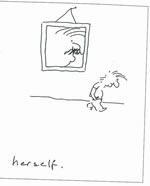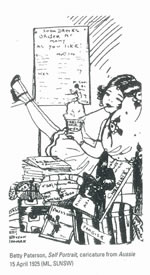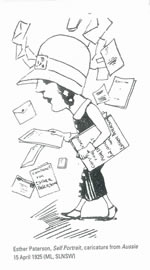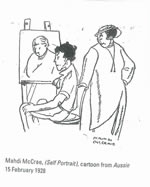Main site navigation
Cartoonists

More information about Jenny Coopes can be found in the AWAP register.
More information about Jean Cullen can be found in the AWAP register.

More information about Betty Paterson can be found in the AWAP register.

More information about Esther Paterson can be found in the AWAP register.

More information about Mahdi McCrae can be found in the AWAP register.
More information about Marie Horseman can be found in the AWAP register.
Jenny Coopes
Jenny Coopes worked as a political cartoonist for the Fairfax organisation for 20 year. She has won three Walkley Awards and was highly commended on another occasion. In 2006 she was an MA student in animation at the University of Technology in Sydney. She was the leading cartoonist on the Sydney Sun Herald in 1985, when the accompanying cartoon was published in a Bulletin supplement 'Australia's Magnificent Cartoonists'. She was the only woman amongst thirty-eight so-called living treasures featured in the supplement. The cartoon, of an artist slinking away after defacing her self-portrait with the addition of a moustache, suggests that even in 1985, to be a cartoonist is to be a man. This despite the obvious existence of women's drawings in publications since the 1890s. The following notes accompany some fine examples.
Jean Cullen
Jean Cullen was an illustrator and humourous artist who worked for Smith's Weekly in the period 1941-1950. She also created the teenage cartoon character 'Pam' for the Brisbane Courier Mail, a character that Marie Horseman continued to develop after Cullen took her own life in 1950.
In 1945, Cullen published an adult illustrated book that was quickly banned called Hold that Halo, or, How to lose it in ten easy lessons. The comic narrated the trials and tribulations of a young woman during the second word war and was a stark commentary on the sexual double-standard as it applied to women.
Excerpt from Hold that Halo, or, How to lose it in ten easy lessons:
"Breathes there a girl with with soul so dead,
Who never to herself hath said:
This is my halo, all my own,
But how I wish the thing were flown."
(with apologies to Sir Walter Scott)Adam and Eve have caused these rhymes
Two souls in Heav'n, with what good times!
They frolicked round thru' every hour.
Eve's halo drop't, with apples sour.
Then Cleo, Egypt's pride of all
Too saw her halo take its fall.
This Nile-ish gal with men galore
Loved many, yet she wanted more.An' this is how it all began
As old-time girls from halos ran.
Perchance 'tis said the story's old
That halos drop if girls be bold.
But let's tell on 'ere you condemn
What halos mean to modern femme.
Betty Paterson
Betty Paterson and her sister Esther were prodigies born into the elite of Melbourne's bohemian set. Father (Hugh) and uncle (John Ford) were both artists and her first playmates were her neighbours, the children of Frederick McCubbin.
Art impinged upon every facet of her life throughout its entire course. Her Art Deco cartoons were published regularly in magazines such as The Bulletin and Aussie. Her illustrated interpretations of 'permissive' 1920s society resonated with those she depicted - she became artist-by-appointment to the flappers.
Marjorie (Mahdi) McCrae
Mahdi McCrae, great-granddaughter of Georgina McCrae was a painter, cartoonist and commercial artist of some renown who had a keen eye for critiquing Sydney society. Norman Lindsay, a close friend of her parents, taught her how to draw. He admired her work greatly, stating that her teenage efforts, many of which were published in Aussie magazine, showed an 'extraordinary delicacy of line and virility of form.' As her reputation grew, her work became more widely published. Throughout the 20s and 30s her drawings were reproduced in Home, Woman, Melbourne Punch and the Bulletin.
Marie (Mollie) Horseman
Mollie Horseman worked professionally as a cartoonist and illustrator for over forty years. In 1963 Everybody's Magazine called her 'Australia's only woman cartoonist'. While this was obviously not the case, she was probably the most visible woman working in the field. At their annual ball in 1956, her colleagues in the Australian Black and White Artists' Club 'smocked' her (presented her with an artist's smock decorated by fellow members) and she was later voted Sydney Savage Club 'Cartoonist of the Year'. In 1964 she was the only woman in a group photograph of forty-three professional cartoonists and one of nine women among 140 cartoonists in the survey exhibition Fifty Years of Australian Cartooning.
Although she was always able to draw, she was propelled forwards when she came to the attention of Norman Lindsay . Rose and Norman employed the teenage Mollie to be their children's governess. So impressed was he, recommended her to the National Art School. For financial reasons, she did not complete the course, but it was enough to sharpen her skills to ensure that she received regular employment. She worked regularly for Smith's Weekly and the Bulletin and her humorous cartoons made her a household name in the 1930s. Perhaps her best known characters were 'The Tipple Twins' two secretaries who regularly created office havoc in the pages of the Rydge's Business Journal, for which she freelanced in the 1940s. Many of her drawings may be found in the Mitchell Library, at the State Library of News South Wales.
Images
Source for Jenny Coopes image: Australia's Magnificent Cartoonists, the Bulletin, 12 November 1985.
All other images are sourced from Joan Kerr, Heritage: The National Women's Artbook